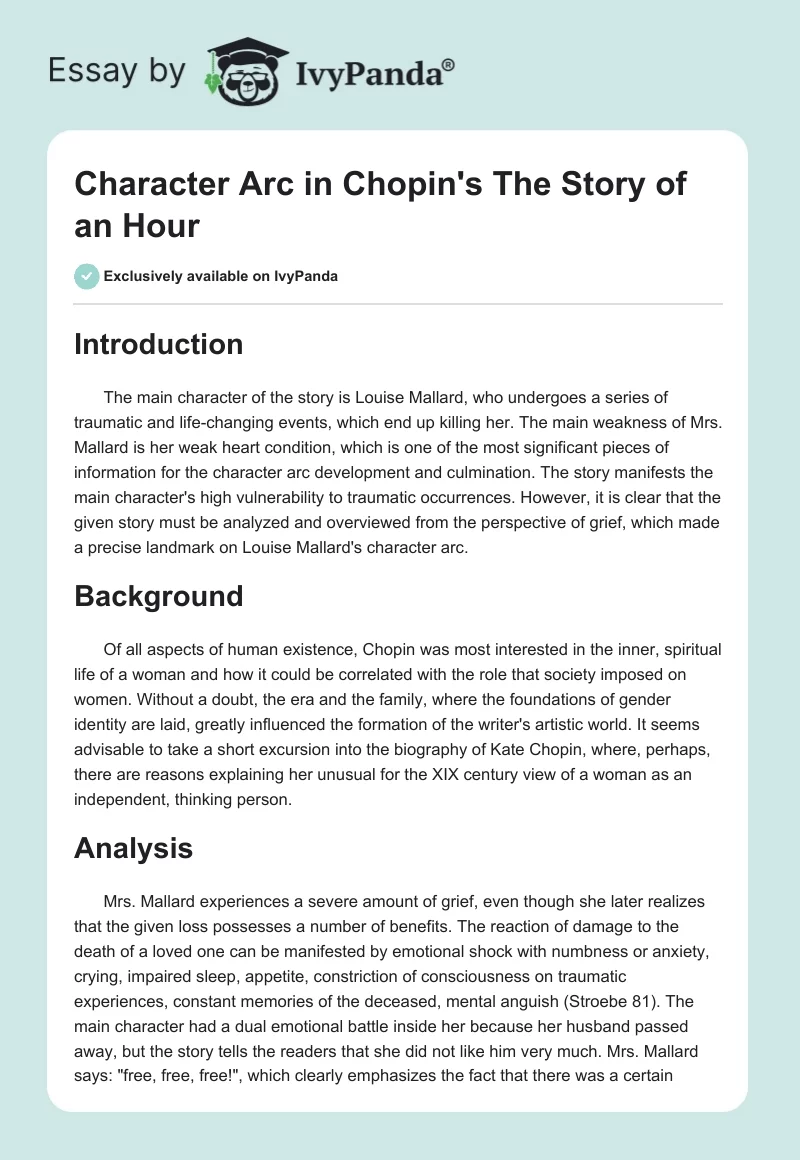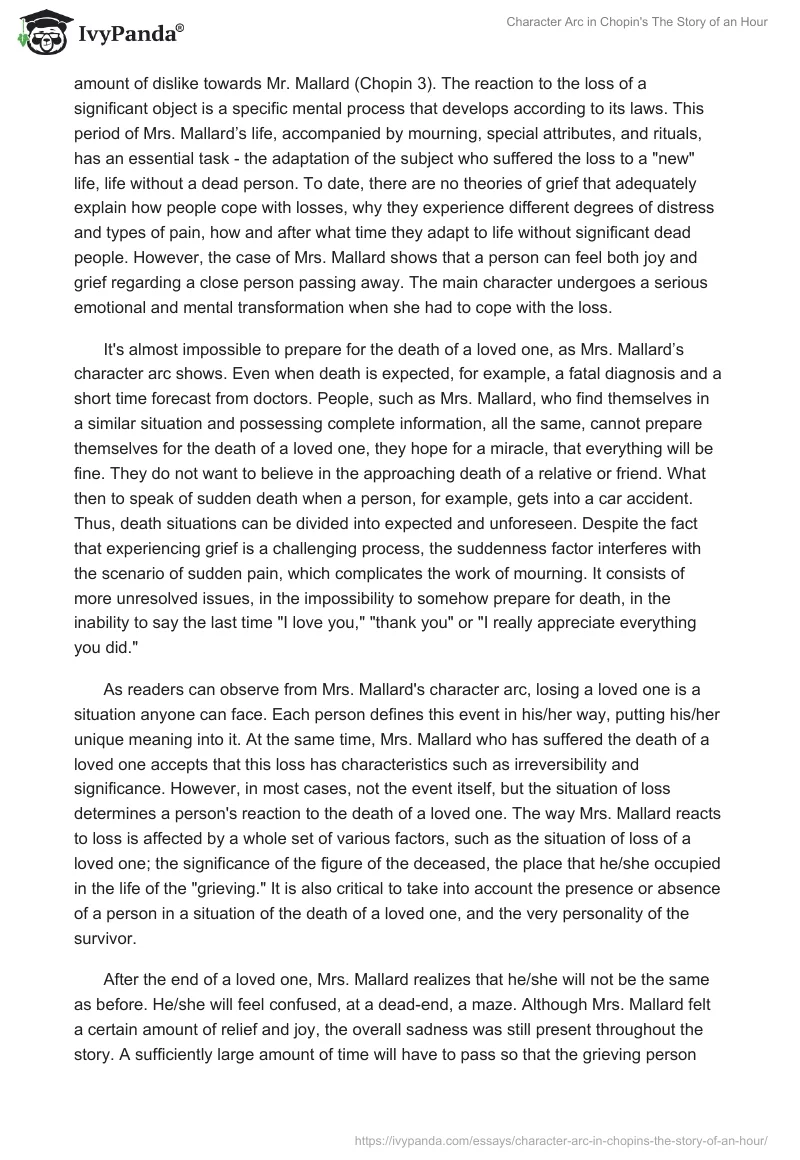Introduction
The main character of the story is Louise Mallard, who undergoes a series of traumatic and life-changing events, which end up killing her. The main weakness of Mrs. Mallard is her weak heart condition, which is one of the most significant pieces of information for the character arc development and culmination. The story manifests the main character’s high vulnerability to traumatic occurrences. However, it is clear that the given story must be analyzed and overviewed from the perspective of grief, which made a precise landmark on Louise Mallard’s character arc.
Background
Of all aspects of human existence, Chopin was most interested in the inner, spiritual life of a woman and how it could be correlated with the role that society imposed on women. Without a doubt, the era and the family, where the foundations of gender identity are laid, greatly influenced the formation of the writer’s artistic world. It seems advisable to take a short excursion into the biography of Kate Chopin, where, perhaps, there are reasons explaining her unusual for the XIX century view of a woman as an independent, thinking person.
Analysis
Mrs. Mallard experiences a severe amount of grief, even though she later realizes that the given loss possesses a number of benefits. The reaction of damage to the death of a loved one can be manifested by emotional shock with numbness or anxiety, crying, impaired sleep, appetite, constriction of consciousness on traumatic experiences, constant memories of the deceased, mental anguish (Stroebe 81). The main character had a dual emotional battle inside her because her husband passed away, but the story tells the readers that she did not like him very much. Mrs. Mallard says: “free, free, free!”, which clearly emphasizes the fact that there was a certain amount of dislike towards Mr. Mallard (Chopin 3). The reaction to the loss of a significant object is a specific mental process that develops according to its laws. This period of Mrs. Mallard’s life, accompanied by mourning, special attributes, and rituals, has an essential task – the adaptation of the subject who suffered the loss to a “new” life, life without a dead person. To date, there are no theories of grief that adequately explain how people cope with losses, why they experience different degrees of distress and types of pain, how and after what time they adapt to life without significant dead people. However, the case of Mrs. Mallard shows that a person can feel both joy and grief regarding a close person passing away. The main character undergoes a serious emotional and mental transformation when she had to cope with the loss.
It’s almost impossible to prepare for the death of a loved one, as Mrs. Mallard’s character arc shows. Even when death is expected, for example, a fatal diagnosis and a short time forecast from doctors. People, such as Mrs. Mallard, who find themselves in a similar situation and possessing complete information, all the same, cannot prepare themselves for the death of a loved one, they hope for a miracle, that everything will be fine. They do not want to believe in the approaching death of a relative or friend. What then to speak of sudden death when a person, for example, gets into a car accident. Thus, death situations can be divided into expected and unforeseen. Despite the fact that experiencing grief is a challenging process, the suddenness factor interferes with the scenario of sudden pain, which complicates the work of mourning. It consists of more unresolved issues, in the impossibility to somehow prepare for death, in the inability to say the last time “I love you,” “thank you” or “I really appreciate everything you did.”
As readers can observe from Mrs. Mallard’s character arc, losing a loved one is a situation anyone can face. Each person defines this event in his/her way, putting his/her unique meaning into it. At the same time, Mrs. Mallard who has suffered the death of a loved one accepts that this loss has characteristics such as irreversibility and significance. However, in most cases, not the event itself, but the situation of loss determines a person’s reaction to the death of a loved one. The way Mrs. Mallard reacts to loss is affected by a whole set of various factors, such as the situation of loss of a loved one; the significance of the figure of the deceased, the place that he/she occupied in the life of the “grieving.” It is also critical to take into account the presence or absence of a person in a situation of the death of a loved one, and the very personality of the survivor.
After the end of a loved one, Mrs. Mallard realizes that he/she will not be the same as before. He/she will feel confused, at a dead-end, a maze. Although Mrs. Mallard felt a certain amount of relief and joy, the overall sadness was still present throughout the story. A sufficiently large amount of time will have to pass so that the grieving person can fully understand and feel “who he or she is now” and see a new, that is, completely different, perspective in life. Before the death of a loved one, his/her life was arranged in a certain way. After such a serious loss, it completely and completely changed. His/her life “schedule,” environment, and other circumstances – everything has undergone enormous changes. For instance, the story explains that: “now her bosom rose and fell tumultuously” (Chopin 2). Accordingly, and therefore also he/she is no longer the same person as he/she was before. He/she lost the man who was part of him, his/her essence.
The main character undergoes a serious stage of contemplation, where she reevaluates her past sacrifices and prospects. Especially when considering this aspect, such a parameter as a social role is significant. The survivor had to be someone’s mom, sister, someone’s dad, cousin, grandfather. After the death of a loved one, of course, he/she remains a mother, sister, or grandfather, but only at the level of memories, in memory. In a real new life, this person is no longer there, and accordingly, the grieving person no longer fulfills that significant social role. It is not so easy to come to terms with such changes. Sometimes personality traits can undergo such strong changes that it may seem to a person as if he/she had completely lost himself. In this case, the survivor asks the question: “Do I really exist?” Somewhere far, far inside himself, he/she realizes that he/she is alive, but simply cannot accept the changes that have occurred to him/her so quickly, he/she does not understand how he/she can live on.
A particular difficulty lies in the fact that a person who finds himself in such a situation will have to re-understand and build his/her structure. More precisely, to answer the questions: “who am I?” “What do I want?” And “by what methods will I achieve my goals?” Often in the life of a person who is faced with the loss of a loved one, dramatic changes occur – from the place of work or the sphere of professional interests to the way of life as a whole. Most people, after the death of someone close to them, begin to value interpersonal relationships more, put a deeper meaning in the concepts of love, friendship, and care, and also pay less attention to the financial situation.
Conclusion
In conclusion, the elimination of cultural stereotypes in the prose of the writer occurs not only thanks to the original interpretation of the “female theme,” but also with the help of certain artistic techniques, such as mimicking literary clichés, and plot variability. The position of the two variants of the character’s fate within the same text, in a sense, anticipates the aesthetic experiments of postmodernism. In the work of Kate Chopin, many of the characteristic features of an entire era converged, but she managed to maintain her unique voice and, as time has shown, she became a truly great writer. The “interrupted flight” by Kate Chopin, the tragic break of her fate, the almost complete oblivion that followed her death, have now been replaced by widespread fame and deserved fame. Her works are an integral part of American literature at the turn of the 19th and 20th centuries – turned out to be extremely consonant with the modern era with its revision of gender stereotypes and the active aesthetic development of the depths of female self-awareness.
Works Cited
Chopin, Kate. The Story of an Hour. Vogue, 1894.
Stroebe, Margaret. “The Poetry of Grief: Beyond Scientific Portrayal.” OMEGA – Journal of Death and Dying, vol. 78, no. 1, 2018, pp. 67-96.


